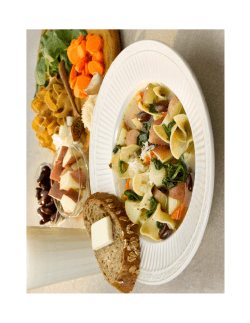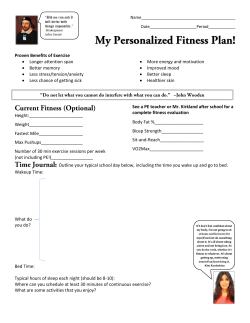
Chapter 7 – Nutrition for Life Worksheet
Chapter 7 – Nutrition for Life Worksheet Section 1: Carbohydrates, Fats, and Proteins List the functions of each class of dietary nutrient. 1. Carbohydrates___________________________________________________________________________________ 2. Fats ______________________________________________________________________________________ 3. Proteins __________________________________________________________________________________ Place an “S” in front of each of the following simple carbohydrates. Place a “C” in front of the complex carbohydrates. ______10. Fiber ______ 7. lactose ______ 4. fructose ______ 8. starch ______ 5. glycogen ______ 9. sucrose ______ 6. glucose Place a “C” in front of each of the following complete proteins. Place an “I” in front of the incomplete proteins. ______11. peas ______13. chicken breast ______15. beans ______12. hamburger ______14. rice ______16. tuna Section 2: Vitamins, Minerals, and Water 1. Compare and contrast vitamins and minerals. _______________________________________________________________________________________________ _______________________________________________________________________________________________ 2. Describe the importance of water to good health. What role does water play in the body? _______________________________________________________________________________________________ _______________________________________________________________________________________________ Match each mineral on the left with its role on the right. ______ 3. copper ______ 4. iron ______ 5. sodium ______ 6. phosphorus ______ 7. iodine Type of Food a. production of hemoglobin b. regulation of water balance c. production of thyroid hormones d. production of bone, red blood cells e. bone formation, cell reproduction Portion Size Milligrams of Calcium Grilled cheese sandwich 1 sandwich 371 Milk (fat-free of low-fat) 1 cup 300 Cheese pizza 1 slice 111–147 Broccoli, cooked or fresh 1 cup 105 Bok choy, cooked or fresh 0.5 cup 80 Almonds, dry roasted 1 ounce 71 White bread 2 slices 70 8. The table above lists the calcium content for some common foods. The numbers are expressed in milligrams. Given that the recommended daily intake of calcium for teens is 1,300 milligrams, how would you choose from among the foods listed to get enough calcium for one day? ________________________________________________________ 9. Urinary tract infections are diagnosed when bacteria are present in the urine in large numbers. Name three healthy behaviors you can develop to prevent urinary tract infections.____________________________________________ ____________________________________________________________________________________________ 10. You are experiencing pain when you urinate and think you may have a urinary tract infection. When you go to the doctor, she asks you to provide a urine sample. Investigate the proper method for clean-catch collection of urine. What are the most important points to remember when collecting a urine sample? _______________________________________________________________________________________________ _____________________________________________________________________________________________ __________________________________________________________________________________________ Explain the effect of each scenario on the excretory system. 11. Jacob has been traveling in a car most of the day and hasn’t been able to drink much water or eat much fruit. _______________________________________________________________________________________________ _____________________________________________________________________________________________ __________________________________________________________________________________________ 12. Muriel ran errands all day long and put off going to the bathroom until her bladder was uncomfortably full. _______________________________________________________________________________________________ _____________________________________________________________________________________________ ____________________________________________________________________________________________ Section 3: Meeting Your Nutritional Needs Analyzing Data: How to Use Food Labels 1. “Serving size” shows the amount of food that counts as one serving. 2. “Calories” lists the number of Calories in one serving and the number of Calories that come from fat. 3. Total fat, saturated fat, cholesterol, sodium, total carbohydrates, dietary fiber, sugars, and protein are listed. 4. “% Daily Value” shows the percentage of the recommended amount of the nutrient that is met by one serving of food. 5. Calcium, iron, vitamin C, vitamin A, and some B vitamins are listed. 6. Recommended daily intakes for 2,000 and 2,500 Calorie diets are listed. 1. Calculate the percentage of Calories from fat in the food. _______________________________________________________________ _____________________________________________________________ 2. Critical Thinking If you needed 2,500 Calories a day, what percentage of DV for fat does a serving of this food provide? _________________________________________________________________ _________________________________________________________________ 3. Explain the functions of the Recommended Dietary Allowances (RDAs), daily values (DVs), and Dietary Guidelines for Americans. _________________________________________________________________ _________________________________________________________________ _________________________________________________________________ _________________________________________________________________ _________________________________________________________________ _________________________________________________________________ _________________________________________________________________ Complete the “ABCs for Good Health” below. ABCs for Good Health Aim for Fitness 4. 5. Build a Healthy Base 6. 7. 8. 9. Choose Sensibly 10.. 11. 12. 13. Section 4 - Choosing a Healthful Diet For each of the foods listed below, suggest a more healthful substitute. How does the substitute help you better meet your body’s needs? For the following health benefit: Instead of . . . soda with my meals I could have . . . water or skim milk to lower my sugar intake a fast-food cheeseburger with fries 1. 2. potato chips 3. 4. fried chicken 5. 6. a sandwich on white bread 7. 8. sour cream chip dip 9. 10. cake with ice cream for dessert 11. 12. white rice 13. 14. candy for snacks 15. 16. 17. What makes a food a “junk food”? Summarize the role junk food can play in a healthful diet. __________________________________________________________________________________________ __________________________________________________________________________________________ __________________________________________________________________________________________ __________________________________________________________________________________________ 18. Create a one-day meal plan that meets the recommendations of the Food Guide Pyramid. Record each food in the table below, and then indicate the number of servings from each group that it represents. Meal Planned Foods Bread, Cereal, Rice, and Pasta Fruit Vegetables Meat, Poultry, Fish, Dried Beans, Eggs, and Nuts Milk, Yogurt, and Cheese Fats, Oils, and Sweets Breakfast Lunch Snack(s) Dinner 19. If your body weight is more (overweight) or below (underweight) which is healthy for you; what adjustments could you make to your food intake? Specifically, what adjustments could you make in regards to serving numbers and sizes? __________________________________________________________________________________________ __________________________________________________________________________________________ __________________________________________________________________________________________ __________________________________________________________________________________________ __________________________________________________________________________________________ __________________________________________________________________________________________ 20. Do you think you need to change your snacking habits in any way? Explain. __________________________________________________________________________________________ __________________________________________________________________________________________ __________________________________________________________________________________________ __________________________________________________________________________________________
© Copyright 2025





















